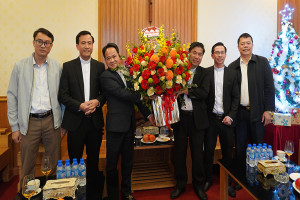
An Giang is a border province with population of 2,1 million people, including over 1,5 million religious followers making 82.1% of the total population, there are 12 religious organizations and denominations in An Giang province including: Buddhism (Mahayana and Khmer Theravada); 4 Caodaist sects (Caodai Tay Ninh Church, Caodai Correct Path Church, Ante-Creation Church, Caodai Verity Church), Catholicism, Protestantism, Islamic, Pure land Buddhist Association, Tứ Ân Hiếu Nghĩa and Bửu Sơn Kỳ Hương. Especially, An Giang province is the birthplace of Hòa Hảo Buddhism, Tứ Ân Hiếu Nghĩa and Bửu Sơn Kỳ Hương.
Compared to other provinces, religion in AN Giang is more diverse. Reasons for this religious diversity includes: the diverse culture of immigrant groups in An Giang province including those of Vietnamese, Khmer, Cham, Chinese; the natural geography provides favorable conditions for both long-established and newly-formed religions to exit and further develop.
An Giang province have 442 lawful religious establishments, over 200 belief-related establishments and several unrecognized religious-related worshipping establishments; 675 religious dignitaries, 2,896 religious. An Giang is also a province where many religious organizations locate its headquarters, including Hòa Hảo Buddhism, Archdiocese of Long Xuyen, Tứ An Hiếu Nghĩa, Bửu Sơn Kỳ Hương and Islamic community. The ethnic Cham and Khmer people in An Giang province reside mainly in districts Tri Ton, Tinh Bien, An Phu, Tan Chau.
Religious organizations in the An Giang province have conducted activities normally and on stable basis; dignitaries, religious and followers well observe policies and guidelines of the Party and State. The authorities at all levels always create favorable conditions for religious organizations and followers to practice religious activities in accordance with state laws and charters of respective religious organizations. Issues of belief and religion have received special attention and thorough guidance from the provincial Party Committee and An Giang People’s Committee.
An Giang is the birthplace of Hòa Hỏa Buddhism, with about 924,935 Hòa Hảo followers, accounting for 44.9% of population, residing in 156/156 communes, wards and towns of 11 districts, cities in the locality. Two most concentrated districts are Phu Tan (about 184,099 followers) and Cho Moi (about 205,023 followers). The teachings of Hòa Hảo Buddhism are very simple, suitable for life, ethics and characters of Southern farmers, so followers voluntarily embrace and consciously practice these teachings in daily life. Hòa Hảo Buddhist followers often take part in important festivals of their religion. Every year, about 400,000 followers make pilgrimage to An Hoa Tu on the occasion of founding anniversary of Hòa Hỏa Buddhism and birthday of prophet Huỳnh Phú Sổ.
Majority of Hòa Hảo Buddhist followers have well observed policies of the Party and law of the State, positively participated in charitable activities. However, due to limited education and social awareness, part of followers are easy prey for abuse and incitement by hostile elements. Certain problems still remain, such as taking advantages of religion to undermine political security and social order in the locality, superstitious activities and internal disunity in some religious organizations.
Under the guidance of the Government Committee for Religious Affairs, An Giang provincial authorities have committed and coordinated with all administrative levels and sectors to resolve religious problems in accordance with the law as well as religious deacons and followers’ supports in order to bring religious activities of Hòa Hảo Buddhism into normal practices, creating open and friendly relationship between local authorities and Hòa Hảo Buddhist followers. The administrative procedures for approval of certain religious activities are resolved quickly and favorably. Religious activities of Hòa Hảo Buddhism have become diverse and charitable activities have been positively and fruitfully encouraged.
The key task of religious affairs is “mobilizing the masses”, so the An Giang Committee for Religious Affairs propagandized and disseminated policies and guidelines of the Party and State on religious affairs, organized dissemination workshops for deacons and followers of Hòa Hảo Buddhism and achieved good results.
Thanks to thorough understanding of religious situation by An Giang Committee for Religious Affairs and open and friendly relationship between authorities and followers of Hòa Hảo Buddhism, State’s administration on Hòa Hỏa Buddhism in An Giang province have created positive exchanges; religious activities have been conducted in accordance with the law; followers of Hòa Hảo Buddhism have enhanced their faith in policies and guidelines of the Party and State on belief and religion.
HDT




